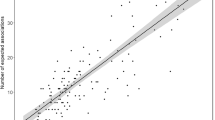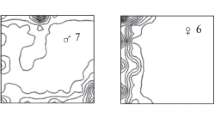Abstract
We examined winter social behaviour of the snow voleChionomys nivalis Martins, 1842, a rock-dwelling microtine found principally in high-mountain biotopes. We conducted dyadic encounters among wild-caughtC. nivalis to determine patterns of intraspecific tolerance and the degree of aggressiveness between and within sexes during wintering periods. Our data show a high frequency of agonistic behaviours in all social encounters. Male pairs spent less time being aggressive than female pairs but more time in investigative behaviours. In contrast, the intensity of aggression displayed during interactions was significantly higher in male-male encounters than in female-female encounters, with an intermediate level of aggression in male-female encounters. The low degree of social tolerance found seems to be in agreement with the available data on the social organization of this species and further suggests that individuals may not spatially associate during over-wintering periods. Although both males and females were socially intolerant, the different patterns observed between the sexes may underlie different strategies.
Similar content being viewed by others
References
Amori G. 1999. Chionomys nivalis (Martins, 1842). [In: Atlas of European mammals. A. J. Mitchell-Jones, G. Amori, W. Bogdanowicz, B. Kryštufek, P. J. H. Reijnders, F. Spitzenberger, M. Stubbe, J. B. M. Thissen, V. Vohralík and J. Zima, eds]. Academic Press, London: 256–257.
Beck L. R. and Anthony R. G. 1971. Metabolic and behavioral thermoregulation in the long-tailed vole,Microtus longicaudus. Journal of Mammalogy 52: 404–412.
Berteaux D., Bergeron J. M., Thomas D. W. and Lapierre H. 1996. Solitude versus gregariousness: do physical benefits drive the choice in overwintering meadow voles? Oikos 76: 330–336.
Bieńkowski P. and Marszałek U. 1974. Metabolism and energy budget in the snow vole. Acta Theriologica 4: 55–67.
Clarke J. R. 1956. The aggressive behaviour of the vole. Behaviour 9: 1–23.
Colvin D. V. 1973. Agonistic behaviour in males of five species of volesMicrotus. Animal Behaviour 21: 471–480.
Cranford J. A. and Derting T. L. 1983. Intra and interspecific behavior ofMicrotus pennsylvanicus andMicrotus pinetorum. Behavioral Ecology and Sociobiology 13: 7–11.
Crowcroft P. and Rowe F. P. 1963. Social organization and territorial behaviour in the wild house mouse (Mus musculus). Proceedings of the Zoological Society of London 140: 517–531.
De Jonge G. 1980. Response to con- and hetero-specific male odours by the volesMicrotus agrestis, M. arvalis andClethrionomys glareolus with respect to competition for space. Behaviour 73: 277–302.
Erlinge S. 1975. Feeding habits of the weaselMustela nivalis in relation to prey abundance. Oikos 26: 378–384.
Ferkin M. H. 1988. The effect of familiarity on social interactions in meadow voles,Microtus pennsylvanicus: a laboratory and field study. Animal Behaviour 36: 1816–1822.
Ferkin M. H. and Seamon J. O. 1987. Odor preference and social behavior in meadow voles,Microtus pennsylvanicus: seasonal differences. Canadian Journal of Zoology 65: 2931–2937.
Gębczyński M. 1969. Social regulation of body temperature in the bank vole. Acta Theriologica 29: 427–440.
Gipps J. H. W. 1981. Behavior of bank voles (Clethrionomys glareolus) in the field. Journal of Mammalogy 62: 382–384.
Gipps J. H. W. 1984. The behaviour of mature and immature male bank voles (Clethrionomys glareolus). Animal Behaviour 32: 836–839.
Gosálbez J. 1987. [Microtus nivalis (Martins, 1842). Snow vole]. [In: Insectivores and rodents of Catalonia. J. Gosálbez, ed]. Ketres S. A., Barcelona: 203–205. [In Catalan]
Gosling L. M., Atkinson N. W., Collins S. A., Roberts R. J. and Walters R. L. 1996. Avoidance of scent-marked areas depends on the intruder’s body size. Behaviour 133: 491–502.
Hayes J. P., Seakman J. R. and Racey P. A. 1992. The contributions of local heating and reducing exposed surface area to the energetic benefits of huddling by short-tailed field voles (Microtus agrestis). Physiological Zoology 65: 742–762.
Hurst J. L., Hall S., Roberts R. and Christian C. 1996. Social organization in the aboriginal house mouse,Mus spretus Lataste: behavioural mechanisms underlying the spatial dispersion of competitors. Animal Behaviour 51: 327–344.
Janeau G. 1980. Répartition écologique des micromammifčres dans l’étage alpin de la région de Brianęon. Mammalia 44: 1–25.
Karlsson A. F. 1986. Social structure in a population of the bank vole,Clethrionomys glareolus. PhD Thesis, Uppsala University, Sweden: 1–146.
Karlsson A. F. 1988. Interindividual proximity and the probability of winter survival in the bank vole,Clethrionomys glareolus. Canadian Journal of Zoology 66: 1841–1845.
King K. 1989. The natural history of weasels and stoats. Christopher Helm, London: 1–253.
Krapp F. 1982.Microtus nivalis (Martins, 1842) — Schneemaus. [In: Handbuch der Säugetiere Europas. Band 2/1: Nagetiere II. J. Niethammer and F. Krapp, eds]. Akademische Verlagsgesellschaft, Wiesbaden: 261–283.
Krebs C. J. 1979. Dispersal, spacing behaviour, and genetics in relation to population fluctuations in the voleMicrotus townsendii. Fortschritte der Zoologie 25: 61–77.
Kryštufek B. and Kovacič D. 1989. Vertical distribution of the snow voleMicrotus nivalis (Martins, 1842) in northwestern Yugoslavia. Zeitschrift für Säugetierkunde 54: 153–156.
Le Louarn H. and Janeau G. 1975. Répartition et biologie du campagnol des neiges Microtus nivalis Martins dans la région de Brianęon. Mammalia 39: 589–604.
Luque-Larena J. J., López P. and Gosálbez J. 2001. Scent matching modulates space use and agonistic behaviour between male snow volesChionomys nivalis. Animal Behaviour 62: 1089–1095.
Madison D. M. 1984. Group nesting and its ecological and evolutionary significance in overwintering microtine rodents. [In: Winter ecology of small mammals. J. F. Merritt, ed]. Special Publication of Carnegie Museum of Natural History, No. 10, Pittsburgh: 285–291.
Madison D. M. and McShea W. J. 1987. Seasonal changes in reproductive tolerance, spacing, and social organization in meadow voles: a microtine model. American Zoologist 27: 899–908.
Madison D. M., FitzGerald R. W. and McShea W. J. 1984. Dynamics of social nesting in over-wintering meadow voles (Microtus pennsylvanicus): Possible consequences for population cycling. Behavioral Ecology and Sociobiology 15: 9–17.
Martín J. and Salvador A. 1992. Tail loss consequences on habitat use by the Iberian rock-lizard,Lacerta monticola. Oikos 65: 318–324.
Maynard-Smith J. and Parker G. A. 1976. The logic of asymmetric contests. Animal Behaviour 24: 159–175.
McShea W. J. 1990. Social tolerance and proximate mechanisms of dispersal among winter groups of meadow voles,Microtus pennsylvanicus. Animal Behaviour 39: 346–351.
Ostfeld R. S. 1985a. Experimental analysis of aggression and spacing behavior in California voles. Canadian Journal of Zoology 63: 2277–2282.
Ostfeld R. S. 1985b. Limiting resources and territoriality in microtine rodents. The American Naturalist 126: 1–15.
Ostfeld R. S. 1990. The ecology of territoriality in small mammals. Trends in Ecology and Evolution 5: 411–415.
Pruitt W. O. Jr 1984. Snow and small mammals. [In: Winter ecology of small mammals. J. F. Merritt, ed]. Special Publication of Carnegie Museum of Natural History, No. 10, Pittsburgh: 1–8.
Siegel S. and Castellan N. J. 1988. Nonparametric statistics for the behavioral sciences. Second edition. McGraw-Hill, New York: 1–312.
Sokal R. R. and Rohlf F. J. 1995. Biometry. Third edition. W. H. Freeman, New York: 1–887.
Tamarin R. H., Ostfeld R. S., Pugh S. R. and Bujalska G. (eds) 1990. Social systems and population cycles in voles. Birkhäuser Verlag, Switzerland: 1–229.
Vickery W. L. and Millar J. S. 1984. The energetics of huddling by endotherms. Oikos 43: 88–93.
Webster A. and Brooks R. J. 1981. Social behavior ofMicrotus pennsylvanicus in relation to seasonal changes in demography. Journal of Mammalogy 62: 738–751.
West S. D. and Dublin H. T. 1984. Behavioral strategies of small mammals under winter conditions: solitary or social? [In: Winter ecology of small mammals. J. F. Merritt, ed]. Special Publication of Carnegie Museum of Natural History, No. 10, Pittsburgh: 293–299.
Wiegert R. G. 1961. Respiratory energy loss and activity patterns in the meadow vole,Microtus pennsylvanicus. Ecology 42: 245–253.
Wolff J. O. and Lidicker W. Z. Jr 1981. Communal winter nesting and food sharing in taiga voles. Behavioral Ecology and Sociobiology 9: 237–240.
Wolff J. O. 1984. Overwintering behavioural strategies in taiga voles (Microtus xanthognathus). [In: Winter ecology of small mammals. J. F. Merritt, ed]. Special Publication of Carnegie Museum of Natural History, No. 10, Pittsburgh: 315–318.
Wolff J. O. 1985. Behavior. [In: Biology of New WorldMicrotus. R. H. Tamarin, ed]. Special Publication, American Society of Mammalogists, no. 8: 340–372.
Ylönen H. and Viitala J. 1985. Social organization of an enclosed winter population of the bank voleClethrionomys glareolus. Annales Zoologici Fennici 22: 353–358.
Ylönen H., Jędrzejewska B., Jędrzejewski W. and Heikkilä J. 1992. Antipredatory behaviour ofClethrionomys voles — ‘David and Goliath’ arms race. Annales Zoologici Fennici 4: 207–216.
Yoccoz N. G. and Ims R. A. 1999. Demography of small mammals in cold regions: the importance of environmental variability. Ecological Bulletins 47: 137–144.
Author information
Authors and Affiliations
Corresponding author
Rights and permissions
About this article
Cite this article
Luque-Larena, J.J., López, P. & Gosálbez, J. Levels of social tolerance between snow volesChionomys nivalis during over-wintering periods. Acta Theriol 47, 163–173 (2002). https://doi.org/10.1007/BF03192456
Received:
Accepted:
Issue Date:
DOI: https://doi.org/10.1007/BF03192456




